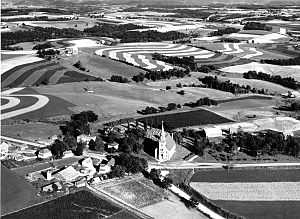Strip farming

- For the Medieval practice of strip farming, see open field system.
Strip cropping is a method of farming used when a slope is too steep or too long, or otherwise, when one does not have an alternative method of preventing soil erosion. Strip cropping alternates strips of closely sown crops such as hay, wheat, or other small grains with strips of row crops, such as corn, soybeans, cotton, or sugar beets.
The growing of a cultivated crop (as corn) in strips alternating with strips of a sod-forming crop (as hay) arranged to follow an approximate contour of the land and minimize erosion.
Strip cropping helps to stop soil erosion by creating natural dams for water, helping to preserve the strength of the soil. Certain layers of plants will absorb minerals and water from the soil more effectively than others. When water reaches the weaker soil that lacks the minerals needed to make it stronger, it normally washes it away. When strips of soil are strong enough to slow down water from moving through them, the weaker soil can't wash away like it normally would. Because of this, farmland stays fertile much longer.
The term strip cropping also refers to a method of dry farming sometimes used in areas including parts of the Great Plains of the United States and the Prairies of Canada. To accumulate moisture in these dry areas, cropland is periodically left fallow. Typically, the fallow and planted areas are organized in parallel long, narrow strips that are oriented normal to the prevailing winds, in order to minimize the erosion of soil from the bare fields. Strip farming helps to prevent mass erosion by having the roots of crops hold on to the soil to prevent it from being washed away.